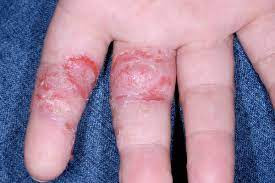What is dyshidrosis:
Dyshidrosis is a skin condition that affects the palms of the hands and the soles of the feet. It causes small, itchy blisters that can last for several weeks and often recur. The exact cause of dyshidrosis is unknown, but it may be related to allergies, stress, or other skin disorders. In this article, we will explore the symptoms, causes, diagnosis, treatment, and prevention of dyshidrosis.
Symptoms of dyshidrosis:
Symptoms of dyshidrosis The main symptom of dyshidrosis is the appearance of small, fluid-filled blisters on the palms of the hands and the soles of the feet. These blisters are usually 1 to 2 millimeters in size and may be grouped in clusters. They can look like tapioca pudding. The blisters are very itchy and can cause pain or discomfort when walking or using the hands. The blisters may also ooze fluid or become infected if scratched.
The blisters usually heal over three weeks, but they often come back after a period of time. Repeated episodes of dyshidrosis can lead to skin thickening, cracking, or peeling in the affected areas.
Causes of dyshidrosis:
Causes of dyshidrosis The exact cause of dyshidrosis is not known, but it is believed to be a type of allergic reaction or a manifestation of a skin disorder. Some possible triggers or risk factors for dyshidrosis include:
- Exposure to certain metals, such as nickel or cobalt, which are often found in jewelry, coins, or tools.
- Exposure to certain chemicals, dyes, or detergents, which can irritate the skin4.
- Stress, which can affect the immune system and trigger inflammation.
- Atopic dermatitis (eczema), which is a chronic skin condition that causes dryness, itching, and inflammation.
- Hay fever or other seasonal allergies, which can sensitize the skin to environmental allergens.
- Sensitive skin, which can react more easily to irritants or allergens.
Diagnosis of dyshidrosis: Dyshidrosis is usually diagnosed based on the appearance and location of the blisters and the history of symptoms. A doctor may also ask about possible triggers or risk factors for dyshidrosis. To rule out other conditions that can cause similar blisters, such as scabies or psoriasis, a doctor may perform a physical examination, a skin biopsy, or an allergy test.
Treatment of dyshidrosis:
Treatment of dyshidrosis There is no cure for dyshidrosis, but there are treatments that can help reduce the symptoms and prevent complications. Some common treatments include:
- Steroid creams or ointments, which can help reduce inflammation and speed up healing. These should be applied as directed by a doctor and only for a short period of time to avoid side effects.
- Antihistamines, which can help relieve itching and prevent scratching.
- Potassium permanganate solution, which can help dry out the blisters and prevent infection. This should be diluted with water and used as a soak for the affected areas.
- Light therapy (phototherapy), which can help reduce inflammation and improve skin barrier function. This involves exposing the skin to ultraviolet (UV) light under medical supervision.
- Oral or injectable medications, such as immunosuppressants or biologics, which can help modulate the immune system and prevent flare-ups. These are usually reserved for severe cases that do not respond to other treatments.
Prevention of dyshidrosis:
- There is no sure way to prevent dyshidrosis, but some measures that may help reduce the frequency or severity of outbreaks include:
- Moisturizing regularly to keep the skin hydrated and prevent dryness.
- Wearing gloves when handling metals, chemicals, or detergents that may trigger dyshidrosis.
- Avoiding contact with allergens or irritants that may cause dyshidrosis.
- Managing stress through relaxation techniques, exercise, or counseling.
- Treating any underlying skin conditions or allergies that may contribute to dyshidrosis.
Conclusion:
Dyshidrosis is a skin condition that causes small, itchy blisters on the palms of the hands and the soles of the feet. It is not contagious and does not pose a serious health threat, but it can cause discomfort and affect the quality of life. The cause of dyshidrosis is unknown, but it may be related to allergies, stress, or other skin disorders. Treatment options include steroid creams, antihistamines, light therapy, and oral medications. Prevention strategies include moisturizing regularly, wearing gloves, avoiding triggers, managing stress, and treating any underlying conditions. If you have symptoms of dyshidrosis, consult your doctor for a proper diagnosis and treatment plan.









.jpeg)
